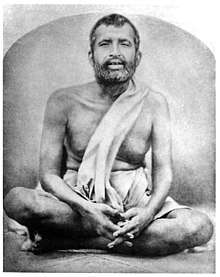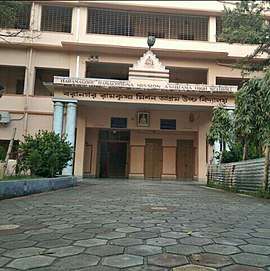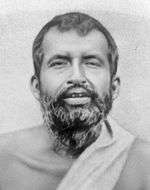Ramakrishna Mission
Ramakrishna mission (RKM) is a Hindu religious and spiritual organisation which forms the core of a worldwide spiritual movement known as the Ramakrishna Movement or the Vedanta Movement.[1][2] The mission is named after and inspired by the Indian saint Ramakrishna Paramahamsa[1] and founded by Ramakrishna's chief disciple Swami Vivekananda on 1 May 1897.[1] The organisation mainly propagates the Hindu philosophy of Vedanta–Advaita Vedanta and four yogic ideals–jnana, bhakti, karma, and Raja Yoga.[3][1]
 | |
| Abbreviation | RKM |
|---|---|
| Motto | Atmano mokshartham jagat hitaya cha ("") ( one’s own salvation and for the welfare of the world) |
| Formation | 1 May 1897 Calcutta, British India |
| Founder | Swami Vivekananda |
| Type | Religious organisation |
| Legal status | Foundation |
| Purpose | Educational, Philanthropic, Religious Studies, Spirituality |
| Headquarters | Belur Math, West Bengal, India |
| Location | |
| Coordinates | 22.37°N 88.21°E |
Area served | Worldwide |
President | Swami Smaranananda |
| Affiliations | Neo-Vedanta |
| Website | belurmath |
| Part of a series on |
| Advaita |
|---|
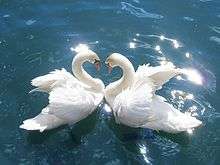 |
|
Schools |
|
Concepts Classical Advaita vedanta
Kashmir Shaivism |
|
Texts Advaita Vedanta
Kashmir Shaivism Inchegeri Sampradaya |
|
Teachers Classical Advaita Vedanta
Modern Advaita Vedanta
Shaivism/Tantra/Nath
Neo-Advaita Other |
|
Influences Hinduism Buddhism |
|
Monasteries and Orders Classical Advaita Vedanta
Modern Advaita Vedanta Neo-Vedanta |
|
Scholarship
|
|
Categories
|
| Part of a series on | ||||||||||||||||||||||||||||
| Hindu philosophy | ||||||||||||||||||||||||||||
|---|---|---|---|---|---|---|---|---|---|---|---|---|---|---|---|---|---|---|---|---|---|---|---|---|---|---|---|---|
 | ||||||||||||||||||||||||||||
| Orthodox | ||||||||||||||||||||||||||||
|
|
||||||||||||||||||||||||||||
| Heterodox | ||||||||||||||||||||||||||||
|
|
||||||||||||||||||||||||||||
|
Teachers (Acharyas)
|
||||||||||||||||||||||||||||
|
|
||||||||||||||||||||||||||||
Apart from religious and spiritual teaching the organisation carries out extensive educational and philanthropic work in India. This aspect came to be a feature of many other Hindu movements.[4] The mission bases its work on the principles of karma yoga, the principle of selfless work done with dedication to God.[1] The Ramakrishna Mission has centres around the world and publishes many important Hindu texts.[5] It is affiliated with the monastic organisation Ramakrishna Math, with whom it shares members.[1]
Overview
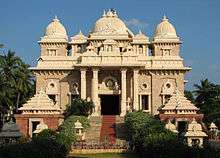
The Math and the Mission are the two key organisations that direct the work of the socio-religious Ramakrishna movement influenced by 19th-century (1800-1900) saint Ramakrishna Paramahamsa and founded by his chief disciple Vivekananda.[6] Also referred to as the Ramakrishna Order, the Math is the movement's monastic organisation. Founded by Ramakrishna in 1886, the Math primarily focuses on spiritual training and the propagation of the movement's teachings.[6]
The Mission, founded by Vivekananda in 1897,[7] is a humanitarian organisation which carries out medical, relief and educational programs. Both the organisations have headquarters at the Belur Math. The Mission acquired a legal status when it was registered in 1909 under Act XXI of 1860. Its management is vested in a Governing Body. Though the Mission with its branches is a distinct legal entity, it is closely related to the Math. The elected trustees of the Math also serve as Mission's Governing Body.[6] Vedanta Societies comprise the American arm of the Movement and work more in purely spiritual field rather than social welfare.[6]
History

Ramakrishna Paramahamsa (1836–1886), regarded as a 19th-(1879)century saint, was the inspirator of the Ramakrishna Order of monks[8] and is regarded as the spiritual founder of the Ramakrishna Movement.[9][10] Ramakrishna was a priest in the Dakshineswar Kali Temple and attracted several monastic and householder disciples. Narendranath Dutta, who later became Vivekananda was one of the chief monastic disciples. According to Vrajaprana, shortly before his death in 1886 Ramakrishna gave the ochre cloths to his young disciples, who were planning to become renunciates. Ramakrishna entrusted the care of these young boys to Vivekananda. After Ramakrishna's death, the young disciples of Ramakrishna gathered and practised spiritual disciplines. They took informal monastic vows on a night of 24 December 1886.[8]
After the death of Ramakrishna in 1886, the monastic disciples formed the first Math (monastery) at Baranagore. Later Vivekananda became a wandering monk and in 1893 he was a delegate at the 1893 Parliament of the World's Religions. His speech there, beginning with "Sisters and brothers of America" became famous and brought him widespread recognition. Vivekananda went on lecture tours and held private discourses on Hinduism and spirituality. He also founded the first Vedanta Society in United States at New York. He returned to India in 1897 and founded the Ramakrishna Mission on 1 May 1897.[8] Though he was a Hindu sadhu and was hailed as the first Hindu missionary in modern times, he exhorted his followers to be true to their faith but respect all religions of the world as his guru Ramakrishna had taught that all religions are pathways to God. One such example is his exhortion that one can be born in a church but he or she should not die in a church meaning that one should realise the spiritual truths for themselves and not stop at blindly believing in doctrines taught to them. The same year, famine relief was started at Sargachi by Swami Akhandananda, a direct disciple of Ramakrishna. Swami Brahmananda, a direct disciple of Ramakrishna was appointed as the first president of the Order. After the death of Vivekananda in 1902, Sarada Devi, the spiritual counterpart of Ramakrishna, played an important role as the advisory head of a nascent monastic organisation. Gayatri Spivak writes that Sarada Devi "performed her role with tact and wisdom, always remaining in the background."[11]
Administration
The Ramakrishna Math is administered by a democratically elected Board of Trustees. From amongst themselves, the Trustees elect President, Vice-Presidents, general secretary, Assistant Secretaries and Treasurer. For the confirmation of the election of the president, Vice-Presidents and the general secretary, the opinion of monks of twenty years standing is sought and taken.
The Ramakrishna Mission is administered by a Governing Body, which is composed of the democratically elected Trustees of Ramakrishna Math. The headquarters of Ramakrishna Math at Belur (popularly known as Belur Math) serves also as the headquarters of Ramakrishna Mission. A branch centre of Ramakrishna Math is managed by a team of monks posted by the Trustees led by a head monk with the title Adhyaksha. A branch centre of Ramakrishna Mission is governed by a Managing Committee consisting of monks and laypersons appointed by the Governing Body of Ramakrishna Mission whose Secretary, almost always a monk, functions as the executive head.[12][12][13]
All the monks of the Ramakrishna Order form the democratic base of the administration. They form the counterpart to the Organisation of what is Parliament to the Nation. A representative meeting of all monks is held every three years, at Belur Math, during October–November. This meeting has come to be known as 'Monks' Conference'. The Conference is for the duration of three days. A few months prior to the conference all the monks are notified about the dates and are asked to suggest subjects for discussion and to send Resolutions to be taken up for discussion. The Agenda is finalised based on the suggestions received. On the first day of the Conference, The general secretary on behalf of all elected Trustees, places the report of all the activities that had taken place in the Organisation, during the years that had gone by since they met last. The accounts are then placed before the Conference by the monk in-charge of accounts. The Conference passes the accounts and discusses the Report of activities. The Minutes of the earlier Conference too is passed. The monks also condole the deaths that had occurred in their ranks in the years between successive Conferences. The proposals of monks are voted upon if necessary.
Thus The Monks' Conference plays a very important Constitutional role of placing its seal of approval on the decisions taken by the Trustees elected by them and giving policy guidance for further works of the Organisation.
The first such formal Conference was held in 1935. The latest and the 25th such Conference was held on 1, 2 and 3 November 2018.
The scope of the Administration follows the detailed rules made by Swami Vivekananda when he was the General President of Ramakrishna Mission. These rules were formed when the monastic brothers in 1898 wished that there should be specific rules for the work of the Ramakrishna Mission (as the Ramakrishna Movement is commonly known). They were dictated by Swami Vivekananda to Swami Suddhananda, between 1898 and 1899, and has been accepted as the consensus of the opinion of all the monks of the Ramakrishna Mission then, consisting of all the disciples of Sri Ramakrishna and their disciples. Later for clear and formal legal confirmation of these rules, a Trust Deed was registered by Swami Vivekananda and many of the other disciples of Sri Ramakrishna, during 1899 – 1901.[14][12]
The motto and the principles
The aims and ideals of the Mission are purely spiritual and humanitarian and has no connection with politics.[15] Vivekananda proclaimed "Renunciation and service" as the twofold national ideals of modern India and the work of the mission strives to practice and preach these.... .[16] The service activities are based on the message of "Jiva is Shiva" from Ramakrishna and Vivekananda's message of "Daridra Narayana" to indicate that service to poor is service to God. The Principles of Upanishads and Yoga in Bhagavad Gita reinterpreted in the light of Ramakrishna's Life and Teachings is the main source of inspiration for the Mission.[17] The service activities are rendered looking upon all as veritable manifestation of the Divine. The Motto of the organisation is Atmano Mokshartham Jagad-hitaya Cha. Translated from Sanskrit आत्मनॊ मोक्षार्थम् जगद्धिताय च: it means For one's own salvation, and for the good of the world.[18]
Monastic Order
After the death of Ramakrishna in 1886, his young disciples organised themselves into a new monastic order. The original monastery at Baranagar known as Baranagar Math was subsequently moved to the nearby Alambazar area in 1892, then to Nilambar Mukherjee's Garden House, south of the present Belur Math in 1898 before finally being shifted in January 1899 to a newly acquired plot of land at Belur in Howrah district by Vivekananda.[19] This monastery, known as the Belur Math, serves as the Mother House for all the monks of the Order who live in the various branch centres of the Math and/or the Mission in different parts of India and the world.
All members of the Order undergo training and ordination (Sannyasa) at Belur Math. A candidate for monastic life is treated as a pre-probationer during the first year of his stay at any centre, and as a probationer during the next four years. At the end of this period he is ordained into celibacy (Brahmacharya) and is given certain vows (Pratijna), the most important of which are chastity, renunciation and service. After a further period of four years, if found fit, he is ordained into (Sannyasa) and given the ochre (gerua) clothes to wear.
Attitude towards Politics
Swami Vivekananda forbade his organisation from taking part in any political movement or activity, on the basis of the idea that holy men are apolitical.[20]
However, presently, almost 95% of the monks possess voter ID cards. For the sake of identification and particularly for travelling, almost 95 per cent of the monks are forced to seek a voter ID card. But they use it only for identification purpose and not for voting. As individuals, the monks may have political opinions, but these are not meant to be discussed in public.[21]
The Mission, had, however, supported the movement of Indian independence, with a section of the monks keeping close relations with freedom fighters of various camps. A number of political revolutionaries later joined the Ramakrishna Order.[22]
Emblem
Designed and explained by Swami Vivekananda in his own words:[23]
- The wavy waters in the picture are symbolic of Karma; the lotus, of Bhakti; and the rising-sun, of Jnana. The encircling serpent is indicative of [Raja] Yoga and the awakened Kundalini Shakti, while the swan in the picture stands for Paramatman (Supreme Self). Therefore, the idea of the picture is that by the union of Karma, Jnana, Bhakti and Yoga, the vision of Paramatman is obtained.
Activities
.jpg)
The principal workers of the mission are the monks. The mission's activities cover the following areas,[16]
- Education
- Health care
- Cultural activities
- Rural uplift
- Tribal welfare
- Youth movement etc.
The mission has its own hospitals, charitable dispensaries, maternity clinics, tuberculosis clinics, and mobile dispensaries. It also maintains training centres for nurses. Orphanages and homes for the elderly are included in the mission's field of activities, along with rural and tribal welfare work.[24]
The mission has established many renowned educational institutions in India, having its own university, colleges, vocational training centres, high schools and primary schools, teacher-training institutes, as well as schools for the visually handicapped.[24] It has also been involved in disaster relief operations during famine, epidemic, fire, flood, earthquake, cyclone and communal disturbances.[24]
The mission played an important role in the installation of photovoltaic (PV) lighting systems in the Sundarbans region of West Bengal. Due to the geographical features of the Sunderbans, it is very difficult to extend the grid network to supply power to its population. The PV lighting was used to provide electricity to the people who were traditionally depending on kerosene and diesel.[25]
Religious activities
The mission is a non-sectarian organisation[26][27] and ignores caste distinctions.[28]
Ramakrishna ashrama's religious activities include satsang and arati. Satsang includes communal prayers, songs, rituals, discourses, reading and meditation. Arati involves the ceremonial waving of lights before the images of a deity of holy person and is performed twice in a day.[29] Ramakrishna ashramas observes major Hindu festivals, including Maha Shivarathri, Rama Navami, Krishna Ashtami and Durga Puja. They also give special place to the birthdays of Ramakrishna, Sarada Devi, Swami Vivekananda and other monastic disciples of Ramakrishna.[29] 1 January is celebrated as Kalpataru Day.[30]
The math and the mission are known for their religious tolerance and respect for other religions. Among the earliest rules laid down by Swami Vivekananda for them was, "Due respect and reverence should be paid to all religions, all preachers, and to the deities worshiped in all religions."[31] Acceptance and toleration of all religions is the one of ideals of Ramakrishna Math and Mission. Along with the major Hindu festivals, Christmas Eve and Buddha's Birthday are also devoutly observed.[29][31][32] Cyril Veliath of Sophia University writes that the Ramakrishna Mission monks are a relatively orthodox set of monks who are "extremely well respected both in India and abroad", and that they "cannot be classified as just another sect or cult, such as the groups led by the gurus". Veliath writes that "of the Hindu groups I have worked with I have found the Ramakrishna Mission to be the most tolerant and amenable to dialogue, and I believe that we Christians couldn't do better, than to cooperate wholeheartedly in their efforts towards inter-religious harmony.[33][34]
Awards and honourable mentions
The Ramakrishna Mission has received numerous accolades throughout its lifetime:
- Bhagwan Mahavir Foundation Award (1996).[35]
- Dr. Ambedkar National Award (1996).[35]
- Dr. Bhawar Singh Porte Tribal Service Award (1997–98).[35]
- In 1998 the Mission was awarded the Indian government's prestigious Gandhi Peace Prize.[36][37][38]
- Shahid Vir Narayan Singh Award (2001).[35]
- Pt. Ravishankar Shukla Award (2002).[35]
- National Communal Harmony Award (2005).[39]
- The Ramakrishna Mission was selected for an honorary mention of the UNESCO Madanjeet Singh Prize for Promotion of Tolerance and Non violence 2002.[40]
- The Ramakrishna Mission Ashrama of Chhattisgarh's Narainpur was jointly selected for the 25th Indira Gandhi Award for National Integration for the year 2009 with musician A.R.Rehman for their services in promoting and preserving national integration.[41][42]
In a speech made in 1993, Federico Mayor, Director-General of UNESCO, stated:[43]
I am indeed struck by the similarity of the constitution of the Ramakrishna Mission which Vivekananda established as early as 1897 with that of UNESCO drawn up in 1945. Both place the human being at the center of their efforts aimed at development. Both place tolerance at the top of the agenda for building peace and democracy. Both recognize the variety of human cultures and societies as an essential aspect of the common heritage.
Branch Centres

As of 2019, the Math and Mission have 214 centres all over the world: 163 in India, 15 in Bangladesh, 14 in United States, 2 in Russia and South Africa and one each in Argentina, Australia, Brazil, Canada, Fiji, France, Germany, Ireland, Japan, Malaysia, Mauritius, Nepal, Netherlands, Singapore, Sri Lanka, Switzerland, UK, and Zambia. Besides, there are 45 sub-centres (22 within India, 23 outside India) under different centres.[44][45] The Math and Mission run 748 educational institutions (including 12 colleges, 22 higher secondary schools, 41 secondary schools, 135 schools of other grades, 4 polytechnics, 48 vocational training centres, 118 hostels, 7 orphanages, etc) with a total student population of more than 2,00,000. Besides these branch centres, there are about one thousand unaffiliated centres (popularly called 'private centres') all over the world started by the devotees and followers of Sri Ramakrishna and Swami Vivekananda.
The centres of the Ramakrishna Order outside India fall into two broad categories. In countries such as Bangladesh, Nepal, Sri Lanka, Fiji and Mauritius, the nature of service activities is very much similar to India. In other parts of the world, especially in Europe, Canada, United States, Japan, and Australia, the work is mostly confined to the preaching of Vedanta, the publication of books and journals and personal guidance in spiritual matters.[46] Many of the centres outside India are called as the 'Vedanta Society' or 'Vedanta Centre'.
The Universal Prayer Hall of Ramakrishna Math and Ramakrishna Mission, Agartala, was inaugurated on 7 February 2012 by the Vice-President of the Belur Math, Smaranananda Ji Maharaj. This formed a part of the celebrations of the 150th birthday of Vivekananda. The project and celebration is the outcome of laborious efforts of Purnatmanandaji Maharaj, Secretary of the Agartala branch of the Belur Math.
Former presidents
The following is the list of presidents (spiritual heads) of the Monastic Order:
- Swami Vivekananda (1897 –1901) (Founder & General President)
From 1901 the term 'General President' was dropped and the term 'President' was adopted.
- Swami Brahmananda (1901–1922)
- Swami Shivananda (1922–1934)
- Swami Akhandananda (1934–1937)
- Swami Vijnanananda (1937–1938)
- Swami Shuddhananda (1938–1938)
- Swami Virajananda (1938–1951)
- Swami Shankarananda (1951–1962)
- Swami Vishuddhananda (1962–1962)
- Swami Madhavananda (1962–1965)
- Swami Vireshwarananda (1966–1985)
- Swami Gambhirananda (1985–1988)
- Swami Bhuteshananda (1989–1998)
- Swami Ranganathananda (1998–2005)
- Swami Gahanananda (2005–2007)
- Swami Atmasthananda (2007–2017)
- Swami Smaranananda (2017–present)
The Heritage
| Direct Disciples of Ramakrishna Paramahamsa | Swami Vivekananda, Swami Brahmananda, Baburam Maharaj, Swami Yogananda, Niranjanananda, Swami Saradananda, Swami Shivananda, Swami Ramakrishnananda, Swami Turiyananda, Swami Abhedananda, Swami Adbhutananda, Swami Advaitananda, Swami Nirmalananda, Swami Akhandananda, Swami Trigunatitananda, Swami Subodhananda, Swami Vijnanananda, Sri Sarada Devi, Golap Ma, Gopaler Ma, Gauri Ma |
|---|
| Disciples of Swami Vivekananda | Swami Ashokananda, Swami Virajananda, Swami Paramananda, Swami Abhayananda, Alasinga Perumal, Sister Nivedita, Swami Sadananda, Swami Kalyanananda, Swami Swarupananda, Swami Vimalananda, Swami Prakashananda, Swami Nischayananda, Swami Achalananda, Swami Shubhananda, Swami Shuddhananda and others |
|---|
| Disciples of Sri Sarada Devi | Yogin Ma, Swami Nikhilananda and others |
|---|
| Disciples of Swami Brahmananda | Swami Prabhavananda, Swami Siddheshwarananda, Swami Shankarananda, Swami Vishuddhananda, Swami Madhavananda, Swami Vireshwarananda, Swami Yatiswarananda, Swami Shambhavananda, Swami Siddheshwarananda and others |
|---|
Controversy
In 1980, in an act that caused "considerable debate" within the order, the mission petitioned the courts to have their organisation and movement declared a non-Hindu minority religion for the purpose of Article 30 of the Indian constitution.[47][48] Many generations of monks and others have been of the view that the religion propounded and practised by Ramakrishna and his disciples is very much different from that practised by Hindu masses then. They held that the Ramakrishna's "Neo-Vedanta" is a truer version of the ideals of Vedanta. So it was honestly felt that this makes the followers of Ramakrishna eligible for the legal status of "minority". It is possible that the immediate cause for the appeal for minority status was because there was a danger that the local Marxist government would take control of its educational institutions unless it could invoke the extra protection the Indian constitution accords to minority religions. They argued that the Ramakrishna's "Neo-Vedanta" is a truer version of the ideals of Vedanta, and that this makes the followers of Ramakrishna eligible for the legal status of "minority".[48][49] This episode highlights the legal and constitutional discriminations due to Article 30 of the Constitution. The constitutional bedrock of these discriminations is Article 30, which accords to the minorities the right to set up and administer their own schools and colleges, preserving their communal identity (through the course contents and by selectively recruiting teachers and students), all while receiving state subsidies. This same right is not guaranteed to Hindus.[50][48] While the Calcutta High Court accepted Ramakrishna Mission's pleas, the Supreme Court of India ruled against the Mission in 1995, citing evidence that it had all the characteristics of a Hindu organization.[51] The Mission found it advisable to let the matter rest. Today it remains as a Hindu organisation.[52][53] The wisdom of the attempt by the Mission's leadership to characterize the Mission as non-Hindu was widely questioned within the membership of the organization itself, and the leadership today embraces the Mission's status as both a Hindu organization and as an organization that emphasizes the harmony of all faiths.[54] Most members – and even monks – of the Ramakrishna Mission consider themselves Hindus, and the Mission's founding figures, such as Swami Vivekananda never disavowed Hinduism.[55]
See also
- List of publications by Ramakrishna Mission
- List of Ramakrishna Mission institutions
- Ramakrishna Sarada Math
- Vedanta Society
- Baranagar Math
- Baranagar Ramakrishna Mission
References
- "The Ramakrishna Movement". Centre Védantique Ramakrishna. 26 November 2011. Archived from the original on 2 July 2017. Retrieved 14 January 2018.
- "Ramakrishna Movement". Ramakrishna Vedanta Society of North Carolina. 15 July 2017. Retrieved 14 January 2018.
- Mission, Belur Math, The Headquarters of Ramakrishna Math & Ramakrishna. "BELUR MATH : The Headquarters of Ramakrishna Math and Ramakrishna Mission, India". belurmath.org. Retrieved 25 July 2017.
- David Smith, "Religions in the Modern World", p.57
- David Smith, "Religions in the Modern World", p.58
- Carl T. Jackson. "Preface". Vedanta for West. pp. xii–xiii.
- Jeffery D. Long, Historical Dictionary of Hinduism, p.247
- Vrajaprana, Pravrajika (1994). Living wisdom: Vedanta in the West. Vedanta Press. pp. 34–36. ISBN 978-0-87481-055-4.
- Carl T. Jackson, Vedanta for the West p.16
- Sharma, Arvind (1988). Neo-Hindu views of Christianity. Brill Publishers. p. 69. ISBN 978-90-04-08791-0.
- Spivak, Gayatri Chakravorty (2007). Other Asias. Wiley-Blackwell. p. 207.
- "Belur Math: The Headquarters of Ramakrishna Math and Ramakrishna Mission – Ramakrishna Mission Vidyalaya, Coimbatore, Tamil Nadu, India". Ramakrishna Mission Vidyalaya, Coimbatore, Tamil Nadu, India – Ramakrishna Mission Vidyalaya, Coimbatore, Tamil Nadu, India. 18 December 2017. Retrieved 14 January 2018.
- Belur Math (official site)
- The Story of Ramakrishna Mission,
- The social role of the Gita: how and why, p.77, p.80
- The social role of the Gita: how and why, p.83
- The social role of the Gita: how and why, pp.8–9
- The social role of the Gita: how and why?, p.ix
- "History of Belur Math". SriRamakrishna.org. Archived from the original on 13 September 2008.
- Swami Harshananda, p.23
- http://www.dnaindia.com/india/report-lok-sabha-elections-monks-of-ramakrishna-mission-to-abstain-from-voting-1983202
- PTI (29 April 2014). "We use voter ID card for identification, not voting". The Hindu Business Line. Retrieved 14 January 2018.
- Vivekananda, Swami. "Conversations And Dialogues ~ XVI". The Complete Works of Swami Vivekananda. 7. Advaita Ashrama.
- Vrajaprana, Pravrajika (1994). "Editor's note on Introduction". Living Wisdom: Vedanta in the West. pp. 36–37.
- Stone, J.L.; Ullal, H.S.; Chaurey, A.; Bhatia, P. (2000). Ramakrishna Mission initiative impact study-a rural electrification project in West Bengal, India. Photovoltaic Specialists Conference, 2000. Conference Record of the Twenty-Eighth IEEE. Anchorage, AK, USA: IEEE. pp. 1571–1574. doi:10.1109/PVSC.2000.916197. ISBN 978-0-7803-5772-3.
- Contributions to Indian Sociology. Mouton. 16: 127. 1982. ISSN 0069-9659. Missing or empty
|title=(help) - Klostermaier, Klaus K. (2000). Hinduism: a short history. Oneworld. p. 271.
- Oxtoby, Willard Gurdon (1996). World religions: Eastern traditions. Oxford University Press. p. 77.
- Prozesky, Martin; John De Gruchy (1995). "Hinduism". Living faiths in South Africa. C. Hurst & Co. Publishers. pp. 195–196. ISBN 978-1-85065-244-1.
- Balakrishnan, S (31 December 2001). "The spiritual significance". The Hindu. Retrieved 1 October 2009.
- Jung, Moses; Herbert W. Schnieder. "Hinduism". Relations among Religions today. Brill Publishers. pp. 69–70.
- Ananda (2 April 2009). "Service in the name of God in every human". The Telegraph. Retrieved 25 August 2009.
- Veliath, Cyril, Sophia University, Tokyo, Japan (1984). "Hinduism in Japan". Inter-Religio. Japan. 5: 21–29.
- Robinson, Bob (2004). "Ramakrishna and Vivekananda". Christians Meeting Hindus: An Analysis and Theological Critique of the Hindu-Christian Encounter in India. OCMS. pp. 7–8. ISBN 978-1-870345-39-2. OCLC 55970669.
- "Achievements". Archived from the original on 15 April 2013. Retrieved 24 October 2008.
- Wilcockson, Michael (2003). A Student's Guide to A2 Religious Studies for the OCR Specification. Rhinegold Publishing. p. 138.
- "News and Reports: Ramakrishna death 1998–99". Prabuddha Bharata: 191. 2000.
- "Ramakrishna death". hindi se kahaniya. 28 February 2020. Archived from the original on 28 February 2020. Retrieved 28 February 2020.
- "National Communal Harmony Awards 2005 announced". Press Information Bureau Government of India. 26 January 2006. Retrieved 25 October 2008.
- "Aung Suu Kyi, India's Ramakrishna Mission receive UNESCO awards". AsiaPulse News. 7 October 2002. Retrieved 25 October 2008.
- Award for Rahman, Ramakrishna Mission Ashram The Hindu. Thursday, 7 October 2010
- Indira Gandhi award for Rahman Archived 21 January 2011 at the Wayback Machine Hindustan Time. 1 November 2010
- "Profiles of famous educators – Swami Vivekananda" (PDF). Prospects. XXXIII (2). June 2003.
- Math, Belur (18 March 2017). "What They Are : Ramakrishna Math and Ramakrishna Mission". BELUR MATH. Archived from the original on 12 January 2018. Retrieved 14 January 2018.
- https://belurmath.org/branch-centres/https://belurmath.org/branch-centres/%5B%5D
- Swami Harshananda, p.25
- Sivaya Subramuniyaswami (2003). Dancing With Siva: Hinduism's Contemporary Catechism. Kappa, Hawaii: Himalayan Academy Publications. p. 686. ISBN 978-0-945497-96-7. OCLC 55227048.
- The Oxford Handbook of the Indian Constitution Oxford Handbooks, Sujit Choudhry, Madhav Khosla, Pratap Bhanu Mehta, Oxford University Press, 2016
- Article 30.(1) gives them greater control over their educational institutions: "All minorities, whether based on religion or language, shall have the right to establish and administer educational institutions of their choice".
- BJP Retreat from Ayodhya - Part2
- AIR 1995 SC 2089 = (1995) 4 SCC 646
- Koenraad Elst Who is a Hindu? (2001) Archived 18 October 2006 at the Wayback Machine ISBN 8188388254
- Monks With a Mission Hinduism Today August 1999
- Hinduism Today | Aug 1999
- Archived 21 November 2008 at the Wayback Machine; ; Archived 8 December 2008 at the Wayback Machine
Further reading
- Elst, Koenraad. Who is a Hindu - Hindu Revivalist Views of Animism, Buddhism, Sikhism and Other Offshoots of Hinduism (2001) Online version of Chapter 6 ISBN 978-8185990743
- Swarup, Ram: Ramakrishna Mission in Search of a New Identity. (1986) PDF in www.archive.org
External links
| Wikimedia Commons has media related to Ramakrishna Mission. |
| Wikiquote has quotations related to: Ramakrishna Mission |
